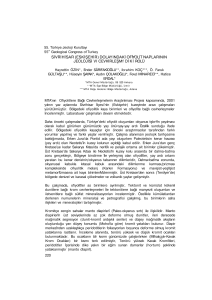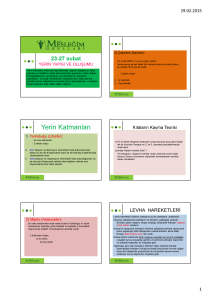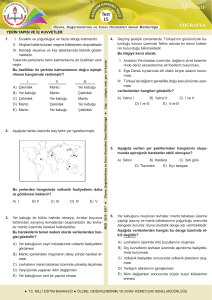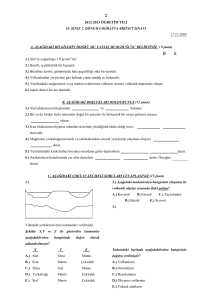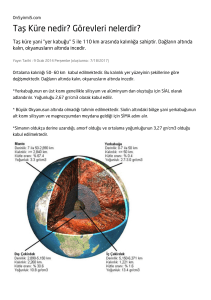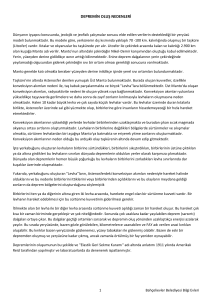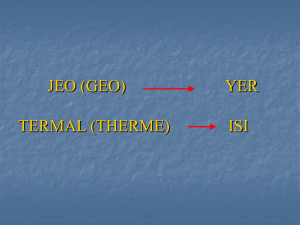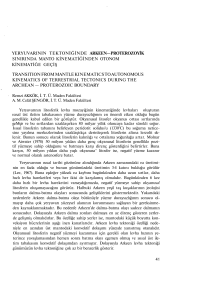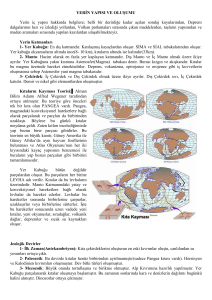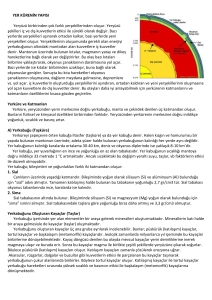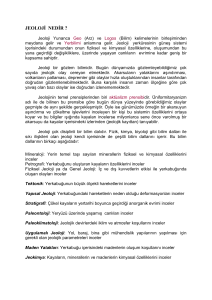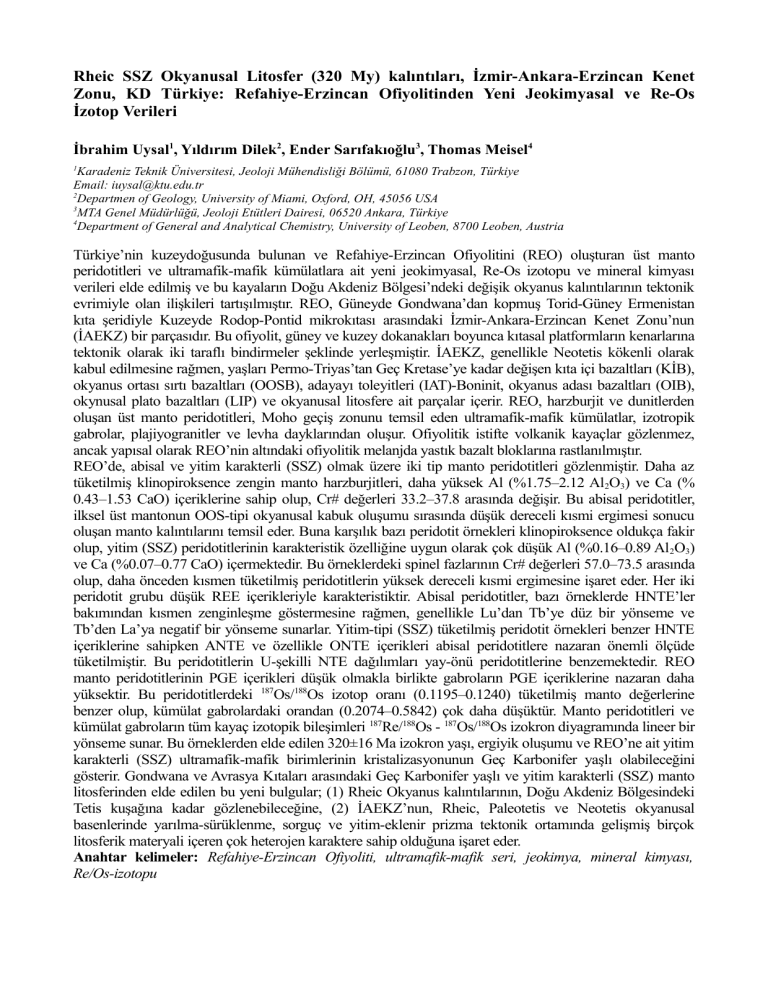
Rheic SSZ Okyanusal Litosfer (320 My) kalıntıları, İzmir-Ankara-Erzincan Kenet
Zonu, KD Türkiye: Refahiye-Erzincan Ofiyolitinden Yeni Jeokimyasal ve Re-Os
İzotop Verileri
İbrahim Uysal1, Yıldırım Dilek2, Ender Sarıfakıoğlu3, Thomas Meisel4
1
Karadeniz Teknik Üniversitesi, Jeoloji Mühendisliği Bölümü, 61080 Trabzon, Türkiye
Email: [email protected]
2
Departmen of Geology, University of Miami, Oxford, OH, 45056 USA
3
MTA Genel Müdürlüğü, Jeoloji Etütleri Dairesi, 06520 Ankara, Türkiye
4
Department of General and Analytical Chemistry, University of Leoben, 8700 Leoben, Austria
Türkiye’nin kuzeydoğusunda bulunan ve Refahiye-Erzincan Ofiyolitini (REO) oluşturan üst manto
peridotitleri ve ultramafik-mafik kümülatlara ait yeni jeokimyasal, Re-Os izotopu ve mineral kimyası
verileri elde edilmiş ve bu kayaların Doğu Akdeniz Bölgesi’ndeki değişik okyanus kalıntılarının tektonik
evrimiyle olan ilişkileri tartışılmıştır. REO, Güneyde Gondwana’dan kopmuş Torid-Güney Ermenistan
kıta şeridiyle Kuzeyde Rodop-Pontid mikrokıtası arasındaki İzmir-Ankara-Erzincan Kenet Zonu’nun
(İAEKZ) bir parçasıdır. Bu ofiyolit, güney ve kuzey dokanakları boyunca kıtasal platformların kenarlarına
tektonik olarak iki taraflı bindirmeler şeklinde yerleşmiştir. İAEKZ, genellikle Neotetis kökenli olarak
kabul edilmesine rağmen, yaşları Permo-Triyas’tan Geç Kretase’ye kadar değişen kıta içi bazaltları (KİB),
okyanus ortası sırtı bazaltları (OOSB), adayayı toleyitleri (IAT)-Boninit, okyanus adası bazaltları (OIB),
okynusal plato bazaltları (LIP) ve okyanusal litosfere ait parçalar içerir. REO, harzburjit ve dunitlerden
oluşan üst manto peridotitleri, Moho geçiş zonunu temsil eden ultramafik-mafik kümülatlar, izotropik
gabrolar, plajiyogranitler ve levha dayklarından oluşur. Ofiyolitik istifte volkanik kayaçlar gözlenmez,
ancak yapısal olarak REO’nin altındaki ofiyolitik melanjda yastık bazalt bloklarına rastlanılmıştır.
REO’de, abisal ve yitim karakterli (SSZ) olmak üzere iki tip manto peridotitleri gözlenmiştir. Daha az
tüketilmiş klinopiroksence zengin manto harzburjitleri, daha yüksek Al (%1.75–2.12 Al2O3) ve Ca (%
0.43–1.53 CaO) içeriklerine sahip olup, Cr# değerleri 33.2–37.8 arasında değişir. Bu abisal peridotitler,
ilksel üst mantonun OOS-tipi okyanusal kabuk oluşumu sırasında düşük dereceli kısmi ergimesi sonucu
oluşan manto kalıntılarını temsil eder. Buna karşılık bazı peridotit örnekleri klinopiroksence oldukça fakir
olup, yitim (SSZ) peridotitlerinin karakteristik özelliğine uygun olarak çok düşük Al (%0.16–0.89 Al 2O3)
ve Ca (%0.07–0.77 CaO) içermektedir. Bu örneklerdeki spinel fazlarının Cr# değerleri 57.0–73.5 arasında
olup, daha önceden kısmen tüketilmiş peridotitlerin yüksek dereceli kısmi ergimesine işaret eder. Her iki
peridotit grubu düşük REE içerikleriyle karakteristiktir. Abisal peridotitler, bazı örneklerde HNTE’ler
bakımından kısmen zenginleşme göstermesine rağmen, genellikle Lu’dan Tb’ye düz bir yönseme ve
Tb’den La’ya negatif bir yönseme sunarlar. Yitim-tipi (SSZ) tüketilmiş peridotit örnekleri benzer HNTE
içeriklerine sahipken ANTE ve özellikle ONTE içerikleri abisal peridotitlere nazaran önemli ölçüde
tüketilmiştir. Bu peridotitlerin U-şekilli NTE dağılımları yay-önü peridotitlerine benzemektedir. REO
manto peridotitlerinin PGE içerikleri düşük olmakla birlikte gabroların PGE içeriklerine nazaran daha
yüksektir. Bu peridotitlerdeki 187Os/188Os izotop oranı (0.1195–0.1240) tüketilmiş manto değerlerine
benzer olup, kümülat gabrolardaki orandan (0.2074–0.5842) çok daha düşüktür. Manto peridotitleri ve
kümülat gabroların tüm kayaç izotopik bileşimleri 187Re/188Os - 187Os/188Os izokron diyagramında lineer bir
yönseme sunar. Bu örneklerden elde edilen 320±16 Ma izokron yaşı, ergiyik oluşumu ve REO’ne ait yitim
karakterli (SSZ) ultramafik-mafik birimlerinin kristalizasyonunun Geç Karbonifer yaşlı olabileceğini
gösterir. Gondwana ve Avrasya Kıtaları arasındaki Geç Karbonifer yaşlı ve yitim karakterli (SSZ) manto
litosferinden elde edilen bu yeni bulgular; (1) Rheic Okyanus kalıntılarının, Doğu Akdeniz Bölgesindeki
Tetis kuşağına kadar gözlenebileceğine, (2) İAEKZ’nun, Rheic, Paleotetis ve Neotetis okyanusal
basenlerinde yarılma-sürüklenme, sorguç ve yitim-eklenir prizma tektonik ortamında gelişmiş birçok
litosferik materyali içeren çok heterojen karaktere sahip olduğuna işaret eder.
Anahtar kelimeler: Refahiye-Erzincan Ofiyoliti, ultramafik-mafik seri, jeokimya, mineral kimyası,
Re/Os-izotopu
Remnants of the Rheic SSZ Oceanic Lithosphere (320 Ma) Within the Izmir-AnkaraErzincan Suture Zone in NE Turkey: New Geochemical and Re-Os Isotope Data From
the Rehafiye-Erzincan Ophiolite
We report on new major-trace-REE and Re-Os isotope compositions and mineral chemistry data from
upper mantle peridotites and ultramafic-mafic cumulate rocks in the Rehafiye-Erzincan ophiolite (REO) in
NE Turkey, and discuss their siginificance for the tectonic evolution of various oceanic tracts in the eastern
Mediterranean region. The REO is part of the Izmir-Ankara-Erzincan Suture Zone (IAESZ) between the
Gondwana-derived Tauride-South Armenian ribbon continent to the south and the Rhodope-Pontide
micro-continent to the north. It shows bidivergent thrusting along its southern and northern boundaries,
resting tectonically on the margins of these continental masses. The IAESZ includes fragments of oceanic
lithosphere with WPB, MORB, IAT-Boninite, OIB and LIP affinities that range in age from the PermoTriassic to the latest Crecateous, although it is commonly interpreted as Neotethyan in origin. The REO
consists of upper mantle peridotites including harzburgite and dunite, ultramafic-mafic cumulate rocks
making up a transitional Moho, isotropic gabbro, plagiogranites, and sheeted dikes. Extrusive rocks are
missing in the ophiolite sequence but occur as blocks of pillow basalts in an ophiolitic mélange
structurally beneath the REO.
We have identified two types of upper mantle peridotites, abyssal and SSZ, in the REO. Less depleted,
clinopyroxene-rich mantle harzburgites have higher concentrations of Al (1.75–2.12 wt.% Al2O3) and Ca
(0.43–1.53 wt.% CaO) and contain spinel phases with Cr# ranging between 33.2 and 37.8. These abyssal
peridotites represent a mantle residue of low degrees of partial melting of primitive upper mantle during
MOR-type oceanic crust formation. Some peridotite samples, on the other hand, are highly depleted in
clinopyroxene and display extremely low contents of Al (0.16–0.89 wt.% Al 2O3) and Ca (0.07–0.77 wt.%
CaO), characteristic of SSZ peridotites. Spinel phases in these samples have Cr# ranging between 57.0
and 73.5, indicating high degrees of partial melting (in a mantle wedge) of previously depleted peridotites.
Both types of peridotites are characterized by low REE contents. Abyssal-type peridotites display a flat
pattern from Lu to Tb and negative-flat pattern from Tb to La, although some samples show slight LREE
enrichment. SSZ-type, depleted peridotite samples are characterized by nearly similar LREE
concentrations, whereas their HREE and especially MREE concentrations are significantly depleted with
respect to those of the abyssal peridotites. These rocks show U-shaped REE patterns, reminiscent of
forearc peridotites. The PGE content of mantle tectonites in the REO, although low, are significantly
higher than those presented by the cumulate gabbros. The 187Os/188Os isotope ratio of these peridotites
(0.1195–0.1240) is typical of the depleted mantle and much lower than those of the cumulate gabbros
(0.2074–0.5842). Whole-rock samples from the mantle tectonites and cumulate gabbros display a welldefined linear trend in a 187Re/188Os vs. 187Os/188Os isochron diagram. These samples collectively define an
isochron with a best-fit age of about 320±16 Ma, suggesting that the melt evolution and crystallization of
the SSZ ultramafic-mafic units of the REO may be as old as the late Carboniferous. This new finding of a
late Carboniferous SSZ mantle lithosphere between the Gondwana and Eurasia continental masses in NE
Turkey indicates: (1) the existence of Rheic Ocean relics farther away in the Tethyan realm of the eastern
Mediterranean region than previously considered; (2) a highly heterogeneous character of the IAESZ,
containing some lithospheric material that evolved in rift-drift, plume and subduction-accretion tectonic
settings of the Rheic, Paleotethyan and Neotethyan Ocean basins.
Key words: Refahiye-Erzincan Ophiolite, ultramafic-mafic series, geochemistry, mineral chemistry,
Re/Os-isotope

